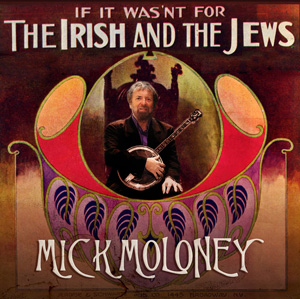You are currently browsing the tag archive for the ‘Tin Pan Alley’ tag.
If It Wasn’t for the Irish and the Jews. Mick Moloney. Compass Records, 2009.
I first enjoyed Mick Moloney and The Green Fields of America some twenty years ago at a national meeting of the American Conference for Irish Studies. Moloney, a talented musician-singer and folklorist who is also a Professor of Music and Irish Studies at New York University, formed the group in the later 1970s and, at least in my memory of the evening, offered a program in which traditional reels, jigs, and step dancing predominated. In the past few years, however, Moloney’s considerable energies have been directed more specifically at America’s Tin Pan Alley era, a time in which Irish and Jewish songwriters—separately and collaboratively—created a popular music expressive of some of the moment’s most pervasive social issues: the struggles of newly arrived immigrants, their often tense internal negotiations between assimilation and nostalgia, and the specter of World War I. Moloney’s earlier album McNally’s Row of Flats (Compass, 2006) treats the highly successful collaboration of Edward Harrigan and David Braham; thus, If It Wasn’t for the Irish and the Jews might be regarded as a further iteration of Moloney’s fascination with American popular music between 1880 and 1920. Read the rest of this entry »
A Fine Romance: Jewish Songwriters, American Songs. David Lehman. New York: Nextbook/Schocken, 2009. 249 pp. ISBN 978-0-8052-4250-8
Creating America on Stage: How Jewish Composers and Lyricists Pioneered American Musical Theater. Jill Gold Wright. Saarbrücken, Germany: VDM Verlag Dr. Müller, 2009. 135 pp. ISBN 978-3-6391-7142-6
An ever-growing body of critical literature, beginning nearly forty years ago with Alec Wilder’s seminal American Popular Song, has established the lasting cultural value of the classic songs of George Gershwin, Jerome Kern, Irving Berlin, Richard Rodgers, and the other great songwriters of what is sometimes called popular music’s “golden era.”[1] (Whether or not one considers that era to have been “golden” has much to do with one’s opinion of rock and roll.) At the beginning of those decades—the 1920s through the 1950s—popular music was dominated by the sheet music publishing industry, centered on a few blocks of West 26th Street in New York City, an area that gave the business its nickname, Tin Pan Alley. But the era also saw the rise of radio and the growth of the recording and movie industries, mass media that eventually eclipsed sheet music as means of disseminating popular songs. The majority of hit songs throughout this period—and in contrast to later phases of popular music history—made their debut in Broadway and Hollywood musicals. Indeed, the history of the popular song in those years is inseparable from the history of the musical comedy. Read the rest of this entry »



